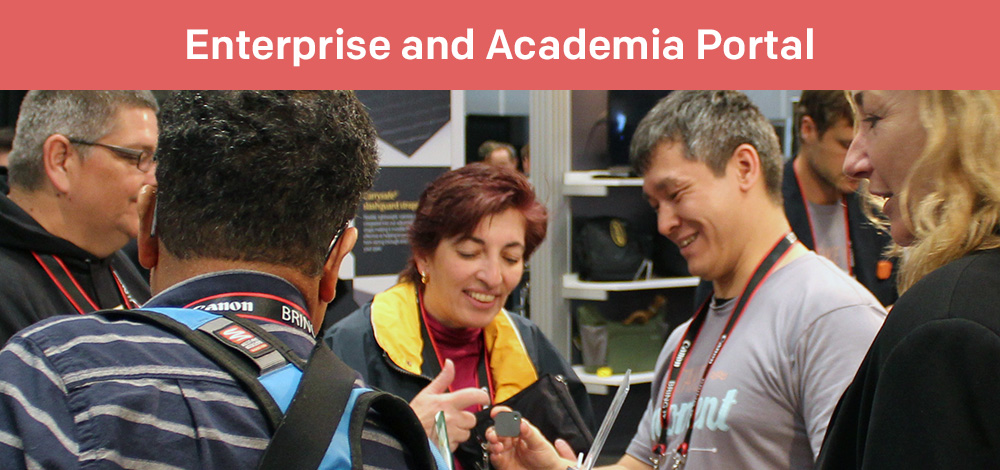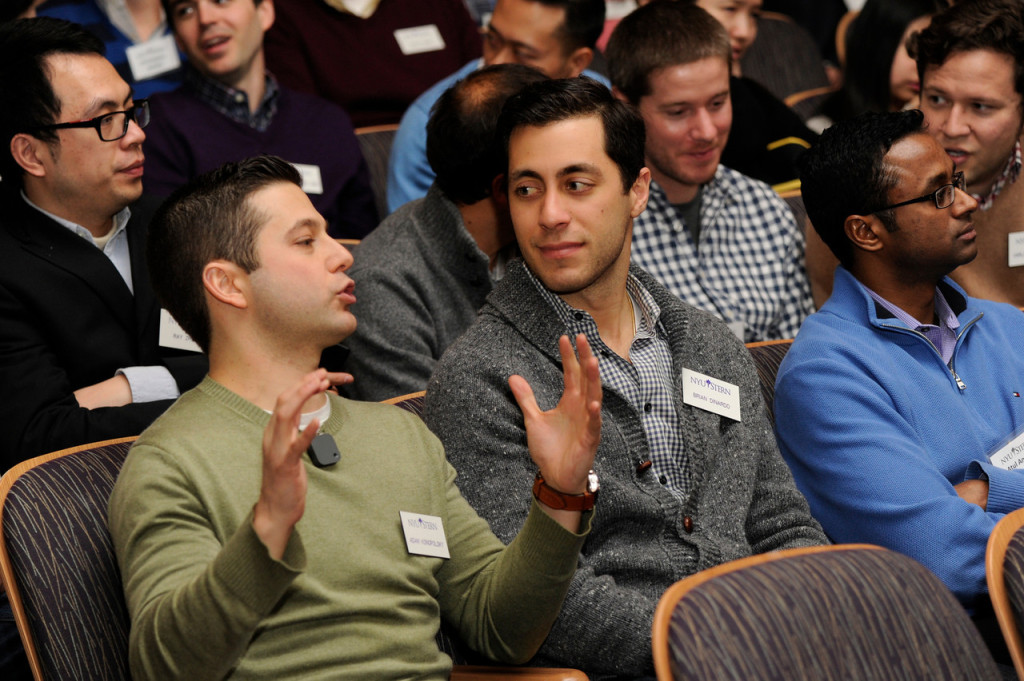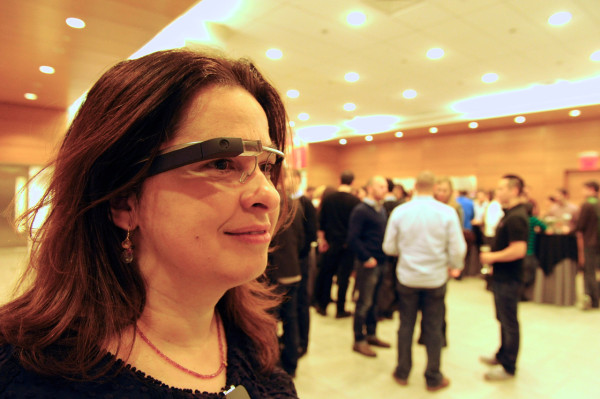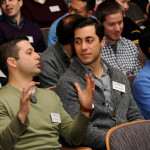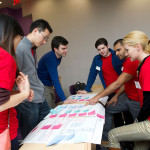How we learn is incredibly important. I’d say most of us remember sitting through lecture after lecture for the majority of our educational experience but there are big questions surrounding the lecture-based approach like, what alternatives are more effective? Different methods of imparting knowledge are working their way into the education system and the Narrative Clip has found its way into the field of pedagogical research. Recently, the Clip was used in a new learning experience called Langone Lab, an orientation program for new MBA students at NYU’s Stern School of Business. This new learning experience was nominated for the 10th annual Campus Technology Innovators Awards and won its category: Education Futurist.
We spoke with Maya Georgieva, the Associate Director at the Center for Innovation in Teaching and Learning at Stern, about the program, award and how the Narrative Clip has been involved.
Program: Langone Lab: An Innovative Orientation Program Leveraging Apps and Wearable Tech to Power New Learning Experiences
Award: Campus Technology Innovator Award – 11 honorees were selected in six categories, out of 215 nominations submitted from higher education institutions around the world.
Category: Education Futurist – visionary learning technology development; new program development; institutional reform; trend spotters: technology and society.
Tell us about the Center for Innovation in general and the program that was directly involved in this project.
The Center for Teaching and Learning (CITL) is a teaching and learning center at the NYU Stern School of Business. We work with faculty and academic groups to enrich courses and programs through the thoughtful application of progressive pedagogy and new media. We partner with faculty to design learning experiences that focus on flipping the classroom, experiential and blended learning models.
Langone Lab Orientation – a two-day program – for the new MBA Stern students was introduced in Fall 2013. The concept of a traditional orientation was flipped — students reviewed materials online and then spent a weekend in an intensive learning experience focused on innovative thinking. In Spring 2014, we introduced a bold educational design powered by cutting edge technology to foster new student learning experiences. The result was an engaging and stimulating orientation program for our new MBA students.
During Langone Lab, student teams were asked to come up with an idea for a new product or service concept. They participated in a design thinking activity. Students used iPads and the ExplainEverything App to creatively prototype their ideas. They recorded a video story of the potential user experience. The students’ experience was captured through wearable technology, including the Narrative Clip Lifelogging Clip camera and Google Glass.
Langone Lab Orientation is an intensive educational experience designed to:
- Expose students to a process of collaborative innovation that maintains a balance between creative intuition and analytical rigor
- Challenge students to think disruptively by expanding their perceptual, conceptual and experimental scope
- Facilitate experiential learning using innovative digital tools
- Capture first-person experiences through the pioneering use of wearable technology
- Inspire students to envision future possibilities
How did you hear about Narrative?
I first saw the Narrative Clip on Kickstarter in December of 2012. I was immediately intrigued by the possibilities of using the Narrative Clip in the context of higher education learning environments, so I backed the project and followed the development of the Clip. I was determined to experiment with the Clip and design a project that would leverage its experimental nature. Last year when we started discussing the idea of a new kind of student orientation I instantly knew that there will be a place for the Narrative Clip in it. I envisioned the use of the Clip to complement the experiential nature of this new learning experience. I did not have bold objectives, as the technology is so new it was important to place in a context where users would engage with it in a natural way. I was curious to see the reaction of students and faculty, hear their questions and continue to push boundaries in terms of learning design and experiences with wearable technology. We are in such an infancy stage of the wearable tech space that it is exciting to design for it. I counted the days to its arrival shortly before the official date for Langone Lab.
What part did the Narrative Clip play in the project?
Throughout the Orientation days, different students from the 35 teams wore the Narrative Clip. We captured the stream of images, we could see the moments of insights, joy and wonder as students participated in the activities in the two days. Selected streams were shared with students. The use of the Narrative Clip complemented the innovative and experiential nature of this new learning experience. Students were excited and intrigued to see the product in use only weeks after its official release. Being in the context of a business school, students not only wore the Clip they also engaged in a number of conversations about the entrepreneurial and technological innovation involved in the making of this product and it potential business and personal use in the future.
Do you see other uses for the Narrative Clip at the Center for Innovation?
We intend to use the Narrative Clip again this fall for our MBA orientation titled Launch and the latest version of Langone Lab. During Launch teams of students will wear the Narrative Clip as they perform their ethnographic research around New York attempting to tackle some of the city challenges. In the future we hope to have students wear them during field trips as they participate in internships and visit businesses in New York city and globally. I think that it would be interesting to explore the opportunity to develop analytics based on the image stream captured by Narrative. I imagine students being able to receive feedback based on the information captured by the Narrative Clip. Today, we all look for analytics coming from web services such as Twitter, Facebook, G+ and others; imagine if we can get a similar feedback from the Narrative Clip and its complementing app on daily activities. Just from scanning my own stream I can see that I prefer talking to a distinct group of people in the office and I can also observe my activities when it comes to how I spent my day and the choices I made on a daily basis. I can see who I made laugh and spot momentary interactions and objects I never had time to notice in the rush of the moment or the day. In the context of the educational experience this type of personal information can reveal a lot about students learning styles and preferences. Finally, it can provide an unbiased look into understanding ourselves or signal possible behavior and other changes. The Quantified Self, personal and learning analytics is an area that personally intrigues me and there is tremendous potential in this area with a device that is nearly transparent.
What features would you like to see added to the Narrative experience (either hardware or software based)?
In the future, the Narrative Clip app may include improved artificial intelligence to create meaningful information from the captured raw data. It would also be interesting to see if the camera can be synchronized with motion or other sensors. Looking at a daily stream may provide more than just a visual journal for our students; it may be able to capture and deliver personalized feedback based on visual data collected. When paired with software that could potentially analyze the data, it would extremely helpful for students to see information on their performance as they participate in different activities and events throughout the day. Data from the streams may prove useful for student to better understand their bio clock and learning aptitudes throughout the day as well as better understand how they relate to different people and environments. The technology for adaptive learning is improving everyday.
What are your thoughts about the Narrative Clip and the future of wearable technology in the teaching/learning process?
My background is in communication arts and global education and this has been my inspiration for understanding the impact of the digital revolution. My work studies the learning sciences and the design of new learning experiences. I have done numerous projects incorporating new media, video storytelling, mobile devices, and for me exploring new technology like the Narrative Clip provides a lens for innovation along with understanding human experience in a digital age.
At some point in the not too distant future, we’ll look back and laugh at how we currently use our Smartphones – that we had to take them out of a pocket to take a photo or to connect with others through social media. We are continuing on a trajectory of technology becoming increasingly miniaturized, more personal and user-friendly. In the end, we are racing toward a highly social, media-rich, deeply interconnected world, where technology will be embedded in or on our bodies. We will be immersed in visual streams of information (both video and images), bio and environmental data, that will transform not only our daily lives, but our understandings of physical and personal space, social interactions and our relationship with time (the way we anticipate the future and retain the past – our personal histories). Everything from the corporate to the retail world – and I might add – education will be transformed.
For this to work both data and storage need to become intelligent and be able to work together, meaning I want the data to be stored but mostly I want my wearable tech to be able to organize, filter and work with my personal preferences and display it to me in a way that I as a human individual can make sense of it. I am not just interested in looking at numbers or even visualizations of numbers; it needs to work contextually, as personalized advice to me.
Wearable Tech is in an intensely innovative period right now. In effect, you could say it’s ahead of where consumers are in terms of the market. Yes, there’s interest – some of it real desire by people to use these devices, but for others just simple curiosity. And of course, there’s a degree of skepticism and resistance.
I have been working on these topics for the last ten years. The future of education is something I think about every single day. The Narrative Clip and wearable tech has the potential to free us from clumsy and bulky interfaces of the past (and the present!) and present us with an opportunity to leverage technology in an incredibly intimate way. Wearables will become part of our daily experience; we will learn, love and express ourselves with them in new and imaginative ways. I am fascinated by these developments and I’m looking forward to the future. I see the Narrative Clip as a significant development in this direction.
